SEMANA SANTA
The official start of the Semana Santa Festival was on Palm Sunday. A small table had been erected in the Plaza Nueva where our favorite cafe usually arranged its chairs. The cafe was closed and a ball of incense was being swung around the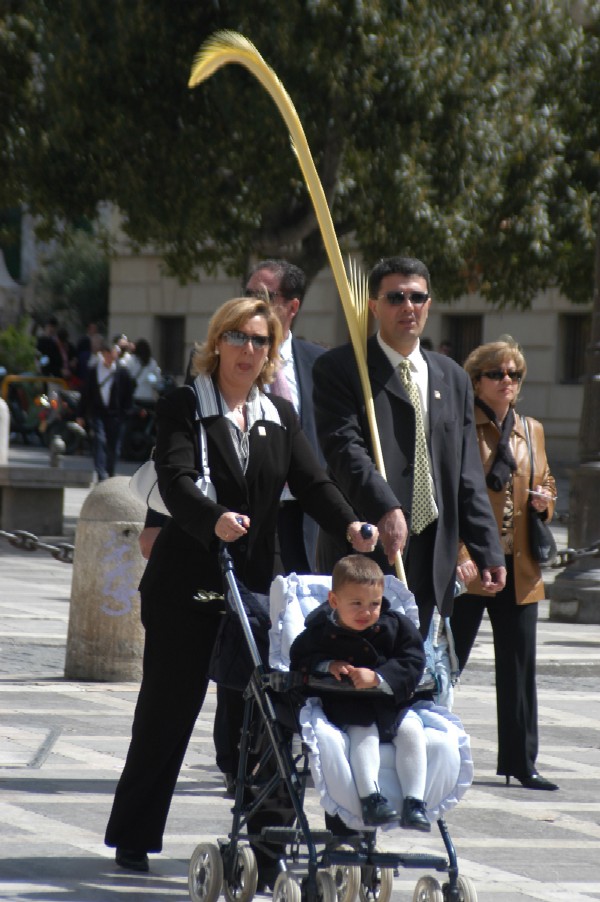 area for purification. The table belonged to one of the many groups that would be making a procession through the streets of Granada in the coming week. We approached the table reticently and were welcomed with smiling faces. The women hosting the table were selling programs, pins, and small hooded figurines, among other religious objects related to the festival. We bought a few things including a figurine and a small program that had an English translation. The festival schedule was still somewhat of a mystery to us as the program we had received from the tourist information office had been only in Spanish so this program would prove very useful to us. As we started to leave one of the women reached over and put small gold stickers on our shirts that said "Semana Santa Granada". area for purification. The table belonged to one of the many groups that would be making a procession through the streets of Granada in the coming week. We approached the table reticently and were welcomed with smiling faces. The women hosting the table were selling programs, pins, and small hooded figurines, among other religious objects related to the festival. We bought a few things including a figurine and a small program that had an English translation. The festival schedule was still somewhat of a mystery to us as the program we had received from the tourist information office had been only in Spanish so this program would prove very useful to us. As we started to leave one of the women reached over and put small gold stickers on our shirts that said "Semana Santa Granada".
As the Sunday masses started and ended we watched people come and go from the churches, dressed in fine clothes, many holding a bit of young palm frond or a bunch of olive leaves in their hands. Some carried the entire length of a palm frond over their shoulder.  It was mostly local people and while the streets were lively the atmosphere was still very peaceful and relaxed. We walked around the down town area, coming upon a couple of more tables selling festive items in front of the Catedral. Stands had been erected in front of the main Catedral doors and in the Plaza del Carmen, marking the ends of the common procession route. All of the processions would start at different churches around the city and slowly proceed towards the Plaza del Carmen. Over many hours the processions would weave their way solemnly through Granada ’s narrow old streets before converging with four or five other processions and passing, in succession, through Granada’s cavernous Cathedral. For a while they would be hidden from sight before emerging again from the side of the Cathedral to make their way back home. It was mostly local people and while the streets were lively the atmosphere was still very peaceful and relaxed. We walked around the down town area, coming upon a couple of more tables selling festive items in front of the Catedral. Stands had been erected in front of the main Catedral doors and in the Plaza del Carmen, marking the ends of the common procession route. All of the processions would start at different churches around the city and slowly proceed towards the Plaza del Carmen. Over many hours the processions would weave their way solemnly through Granada ’s narrow old streets before converging with four or five other processions and passing, in succession, through Granada’s cavernous Cathedral. For a while they would be hidden from sight before emerging again from the side of the Cathedral to make their way back home.
The first procession on Palm Sunday was scheduled to depart the Santuario del Perpetuo Socorro at 4:30 and as the time approached we noticed a steady stream of people filing off in one direction. We followed and ran into a massive crowd surrounding the door of the church. Working our way around the nearby alleyways we found a spot along the procession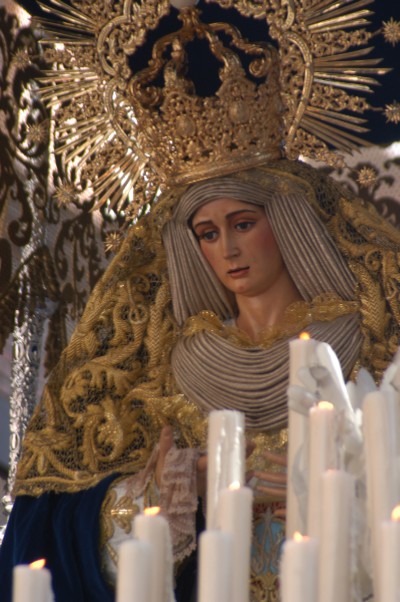 route, just down the street, and waited. The start of the procession was prolonged and dramatic. Rows of figures clad in long blue robes with tall pointed white hoods stretching down over their faces slowly emerged from the church, the first row wielding an enormous silver cross. There was a deep pounding of drums followed by the piercing squeal of horns. The procession moved methodically down the street, expressionless figures with only eyes showing beneath their hoods. The surrounding crowds were respectfully silent. After some time a tall palanquin bearing the image of Jesus In Jerusalem (1917) appeared at the doorway of the church. He was riding a mule with a palm tree above his head. At the high arched doorway the icon came to a halt and was carefully lowered onto its wooden legs. There was a pause. route, just down the street, and waited. The start of the procession was prolonged and dramatic. Rows of figures clad in long blue robes with tall pointed white hoods stretching down over their faces slowly emerged from the church, the first row wielding an enormous silver cross. There was a deep pounding of drums followed by the piercing squeal of horns. The procession moved methodically down the street, expressionless figures with only eyes showing beneath their hoods. The surrounding crowds were respectfully silent. After some time a tall palanquin bearing the image of Jesus In Jerusalem (1917) appeared at the doorway of the church. He was riding a mule with a palm tree above his head. At the high arched doorway the icon came to a halt and was carefully lowered onto its wooden legs. There was a pause.
A skirt covered the heavy base of the palanquin, hiding its legs and the bearers packed underneath. All that could be seen of the densely packed group of icon bearers were the rows of feet protruding from the bottom of the skirt, some barefoot. There were at least twenty, maybe more. They carefully kneeled in unison to bring the top of the icon down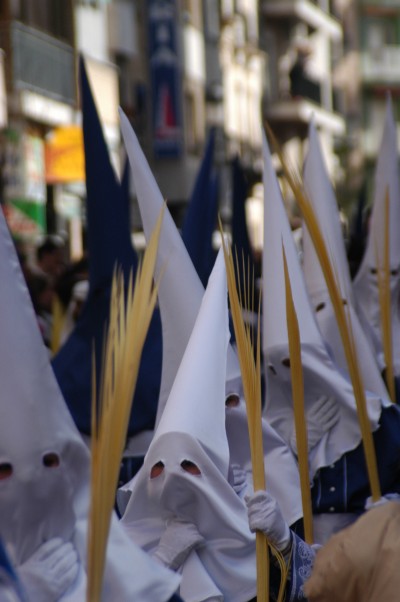 to the height of the door and then inched along the cobblestone pavement on their knees until the icon cleared the archway. There was another pause and then, in a thrust of power, they hoisted the icon to shoulder height and continued shuffling down the street. The crowds cheered and clapped. The first icon of the Pasion por had embarked on its annual procession through the streets of the city. to the height of the door and then inched along the cobblestone pavement on their knees until the icon cleared the archway. There was another pause and then, in a thrust of power, they hoisted the icon to shoulder height and continued shuffling down the street. The crowds cheered and clapped. The first icon of the Pasion por had embarked on its annual procession through the streets of the city.
We watched with intrigue as hundreds of hooded faces passed us by, just eyes peeking through satin cloth, mysterious and almost sinister looking. These were the Nazarenes. They were accompanied by a hundred small children dressed as Hebrews, holding bits of palm fronds in their hands. The icon of Jesus towered above the crowd, appearing to have come to life in his new worldly surroundings. He was followed by rows of mourning women dressed in black with lace mantillas draped down their backs, rosaries in one hand and a candle in the other. The procession was long and the marching band was separated into two groups at either end to provide cadence for the movement. After an equally dramatic exit, Our Lady of Peace (1974) appeared, protectively covered in an ornate canopy, rows of candles giving her face a soft glow, her glorious gown trailing behind. As the icon bearers shuffled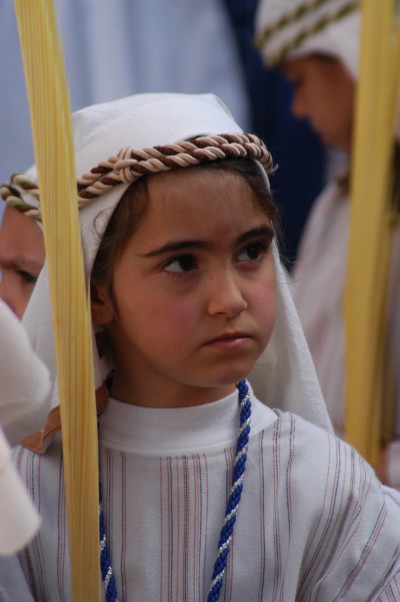 along the delicate canopy swayed to the rhythm of the drums. along the delicate canopy swayed to the rhythm of the drums.
These icons spent the year safely positioned in alcoves of the churches to which they belonged, only to be removed and positioned on their elaborately decorated platforms for Semana Santa. The weight of the icon and heavy base were substantial and the procession periodically came to a halt while the icons were lowered onto their legs and the bearers rested. After a short respite the knocker attached to the front of the platform would be gently tapped and the bearers would hoist the icon into the air with enough energy to make it briefly leave their shoulders. The crowds always applauded this immense effort.
With the gentle pace of the procession there was plenty of time to see everything. The spectators were eager but remained patient and just as crowds formed to see a procession the people also quickly disbanded after it had passed. The participants remained solemn but could not help giving way to smiles and waves when they saw people they knew. This week long festival honoring Christ's sacrifice to humanity was a serious event but not without the social sense of community that came from bringing people together.
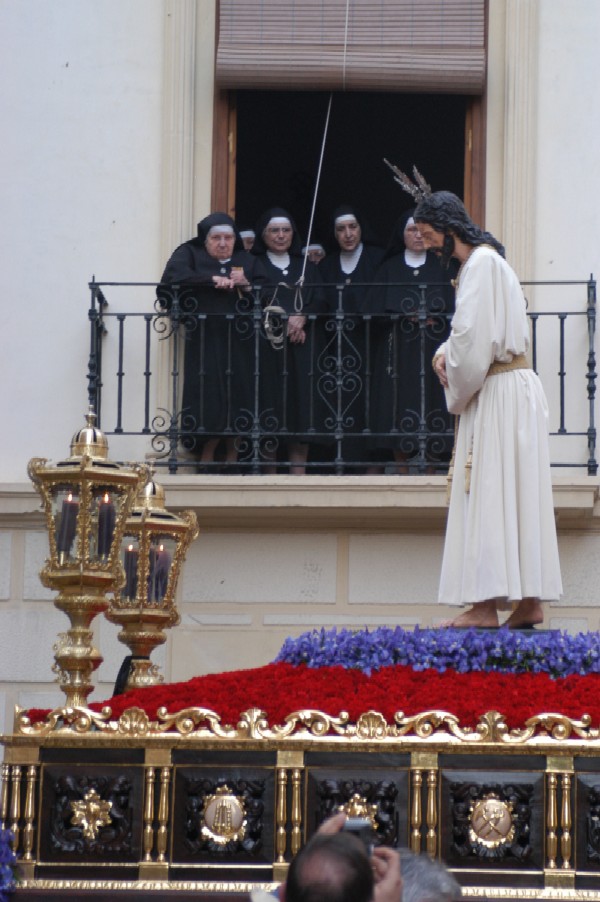 The next procession didn't start until 6:15 but during this time the first one continued to slowly make its way through the winding streets of Granada, towards to official tribunal. We consulted our map and waited to see Jesus Cautivo (1983) and Maria Santisima de la Encarnacion (1982) carefully navigate their way through some of the cities narrowest streets. The drama of this procession was increased when it passed a convent and a row of nuns were caught overlooking the icons from their balcony. The next procession didn't start until 6:15 but during this time the first one continued to slowly make its way through the winding streets of Granada, towards to official tribunal. We consulted our map and waited to see Jesus Cautivo (1983) and Maria Santisima de la Encarnacion (1982) carefully navigate their way through some of the cities narrowest streets. The drama of this procession was increased when it passed a convent and a row of nuns were caught overlooking the icons from their balcony.
|

